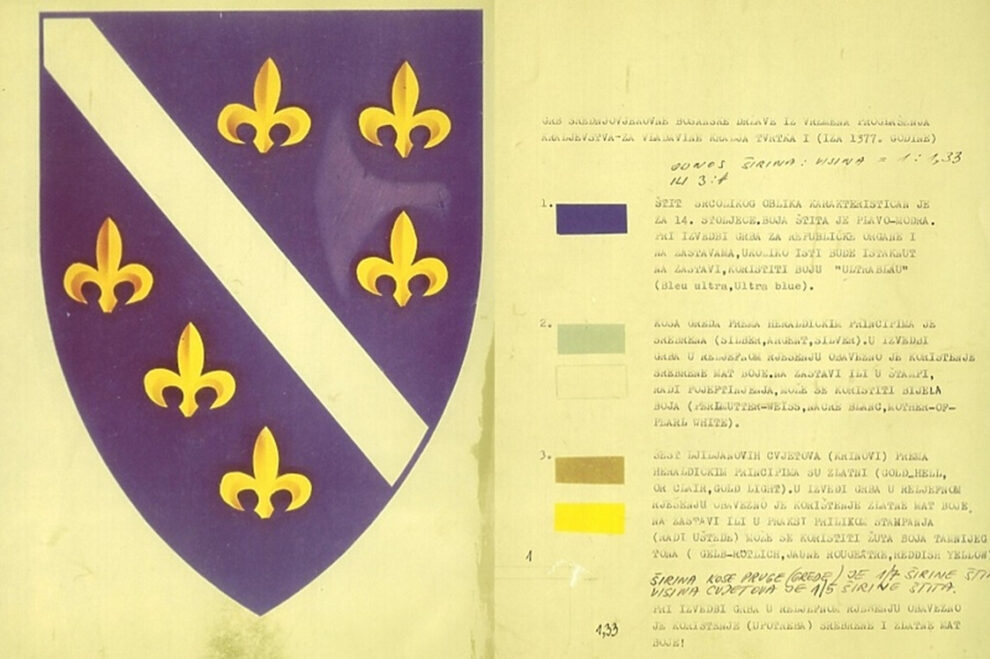Exactly 31 years ago today, on May 5, 1992, the Presidency of the Republic of Bosnia and Herzegovina accepted the offered solutions for the coat of arms and flag of the Republic of Bosnia and Herzegovina, which officially gave our country its state features.
At the beginning of the 1990s, there was a need for new state emblems to replace the previous communist ones, the most convenient was to go back to the Middle Ages, when medieval Bosnia at that time had heraldic symbols. The goal was to emphasize the renewed Bosnian statehood, and to emphasize national neutrality.
Born at the dawn of war
By choosing a symbol from the distant past, an effort was made to avoid raising national tensions, which were at their peak at the time. The birth of the new flag of Bosnia and Herzegovina began on February 27, 1991, when the Assembly of the SR of Bosnia and Herzegovina, on the proposal of 86 deputies, adopted the Decision to change the Constitution of the SR of Bosnia and Herzegovina, and to adopt a constitutional law on the name and state symbols of the Republic of Bosnia and Herzegovina.
The working group appointed expert groups composed of eminent scientists who were to determine the appearance and graphic presentation of the new state symbols of the Republic of Bosnia and Herzegovina.

The flag of the RBiH in front of the BiH Presidency (Photo: EPA-EFE)
The expert group consisted of archeologist Hasan-Mirza Ćeman and historian Tihomir Glavaš from the National Museum, Dr. Boris Nilević from the Institute of History, and independent designer Zvonimir Bebek was hired for the visual design of the ideal solution. The team included Enver Imamović, a professor of ancient history at the Faculty of Philosophy in Sarajevo, while Vedran Hadžović, a law graduate, was chosen as the coordinator and secretary of the expert group. The legal consultant on behalf of the Constitutional Court of SR BiH was Kasim Trnka.
Multiple symbols
It was suggested that the basic color of the new flag be light blue, modeled after the color of the United Nations flag. It was also suggested that it be rectangular in shape and proportion 5:3.
The expert group decided that the new state symbol should be a lily from the era of the Bosnian kingdom, because it does not represent any special ethnic group in Bosnia and Herzegovina. They also recommended that the origin of the lily should be based on the endemic Bosnian subspecies that grows on the slopes of the Igman and Sutjeska mountains, Lilium bosniacum. Furthermore, it has been suggested that the banner spear should end in a stylized lily flower tip instead of the usual warrior spear.
The new symbols were presented to the cultural societies Preporod, Napredko, Prosvjeta and La Benevolencija, in order to listen to and agree on possible suggestions. All societies agreed to the proposed solution, except Serbian Prosvjeta, which was of the opinion that Serbian symbols must be an integral part of the new flag.
Due to the outbreak of war, the expert subgroup was unable to complete its work. Their proposals were to be submitted to the constitutional procedure, after which the official declaration of the new state symbols would follow. However, the whole process was suspended because the commission disbanded. Then Enver Imamović and Zvonimir Bebek continued their work independently and within 40 days made “cosmetic changes” in which they changed the color of the border of the coat of arms from silver to gold and the basic color of the flag from light blue to white. They also completed the work on the military insignia, where the coat of arms remained the same as the national coat of arms, with the fact that two crossed swords were shown behind the shield. The work was completed at the beginning of May 1992.
She turned around in front of the UN
At its session of May 4, 1992 (Decree No. 02-011-343/92), the Presidency of the Republic of Bosnia and Herzegovina accepted the offered solutions for the coat of arms and flag without any objections, which made these symbols official state symbols, as a temporary solution, while the revised text of the Constitution of RBiH from 1993, Article 7 for the coat of arms and Article 8 for the flag, adopted as a permanent and final solution.
A little later, on May 22, 1992, the hand-sewn flag of the Republic of Bosnia and Herzegovina was flown in front of the building of the United Nations General Assembly.

The white jerseys of the national football team are a kind of legacy of the RBiH flag
The Dayton Agreement predicted that Bosnia and Herzegovina would receive new features that were to be agreed upon by the future authorities, and until then the flag of the RBiH would be valid. The Bosnian and Croatian sides agreed to “neutral” solutions, but the Serbian side demanded that national symbols be found on the new flag. Since an agreement could not be reached, the new flag was imposed in 1998 by the then High Representative Carlos Westendorp.
Source: klix















